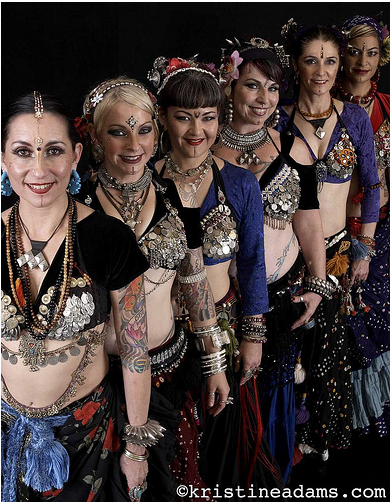The Origins of “Tribal Style Belly Dance”
The origins of Tribal Style Belly Dance are attributed to Jamila Salimpour, the “grandmother of Tribal Dance”. Jamila started teaching a “composite of belly dance styles” in 1949. Her syllabus derived from her meticulous research of Middle Eastern dance since early childhood. Her belly dance format of the 1960s is the foundation of contemporary belly dance. In 1968, on the occasion of the Renaissance Pleasure Fair in Berkeley/US, Jamila coincidentally founded her dance troupe Bal Anat (the oldest American Tribal troupe in existence nowadays). She created a circus inspired variety show, presenting amongst others Algerian water glass dance, snake and sword dance, Tunisian pot dance and male tray dance. In many respects Bal Anat (roughly translated to the Dance of the Mother Goddess) is the first representation of fusion in the history of Tribal Style Belly Dance.
Jamila Salimpour composed the original Danse Orientale in the 1970s. Her belly dance manual introduced belly dance terminology, which is commonly referenced by modern belly dancers today. Some examples are terms like Basic Egyptian, Arabic, Turkish drop, or Maya. In 1992, Jamila’s daughter Suhaila Salimpour revised the original document. She skillfully elevated Jamila Salimpour material by introducing a technique based approach based on a sound anatomical breakdown of belly dance isolations. Suhaila Salimpour technique is now known worldwide as a fundamental framework to“create better dancers through better technique” whatever your preferred stylization (be it traditional Raqs Sharqi, Tribal Fusion and others).
Masha Archer, a former Bal Anat dancer, eventually left Bal Anat to form her own troupe. Her student Caroleena Nericcio subsequently introduced Fat Chance Belly Dance (FCBD), and created a style which heavily relies on the concept of group improvisation guided by cued movement sequences. The format is referred to as American Tribal Style (ATS). It is interesting to note that the Middle Eastern and Gypsy Dance inspired, earthy and eclectic, costuming of the Bal Anat dancers informed the tribal look of Masha’s troupe. Both Masha Archer and Caroleena Nericcio perpetuate the idea of powerful femininity and the notion of the Goddess. Dancers who originally studied Fat Chance Bellydance format like Jill Parker, Paulette Rees- Denis and Kajira Djoumanah have since founded their own troupes, contributing their own dance formats.
The Conception of Tribal Fusion
Jill Parker became the founder of the Tribal Fusion troupe Ultra Gypsy. Expanding ATS vocabulary, Jill added new movements that resulted in a style that is referred to nowadays as Tribal Fusion. The Tribal Fusion concept allowed for a more individualized interpretation of Belly Dance. Depending on personal dance backgrounds, dancers began to fuse belly dance vocabulary with Western dance styles such as Flamenco, Contemporary Dance, Hip Hop and many more. Internationally renowned professionals like Rachel Brice, Mardi Love, Zoe Jakes, The Lady Fred and Samantha Emanuel perfectly exemplify Tribal Fusion Bellydance. New embodiments of fusion are constantly evolving, Gothic Fusion (Ariellah), Burlesque Fusion and Urban Fusion (Heather Stants) to name but a few. These styles also represent a different esthetic to traditional Tribal Style. They tend to be more minimalist and contemporary in nature as opposed to the heavy ethnic jewelry, many layers of circular skirts and headpieces often worn by Tribal dancers.
The concept of Modern Fusion Belly Dance
Jasmin Victoria envisions a fusion of modern contemporary dance elements with belly dance.
The essentially light quality of Modern Dance and its continuous play between tension and suspension perfectly balances out the earthy quality of belly dance, almost providing a juxtaposition between the feminine (yin) and masculine (yang).



